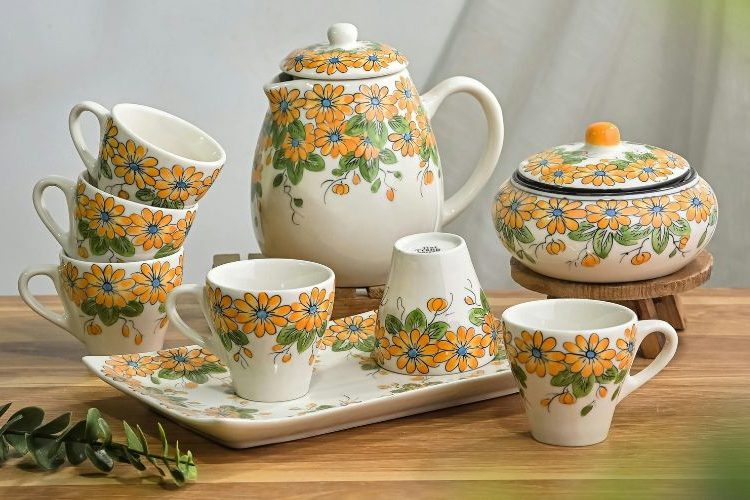Pottery from Vietnam is already present in many countries, including demanding markets like the US and Europe. This shows that Vietnamese ceramics combine both fine design and reliable quality.
If you are considering how to import pottery from Vietnam but are not sure where to start, this guide will give you some direction. We will look at which products are popular with buyers, how to find trustworthy suppliers, and what paperwork you need for customs. By the end, you should have a clearer idea of how to make your first import smooth and successful.
A Quick Glance at Vietnam’s Pottery Market
Vietnam has become one of the top pottery exporters in the world, currently ranked ninth. It is also among the top three suppliers outside the EU sending decorative ceramics into Europe. In 2024 alone, Vietnam shipped out more than 674 million USD worth of pottery, a solid 9 percent increase from the year before. The products that buyers look for most are handmade household ceramics, home décor items, and ceramics used in construction.
The momentum is still strong in 2025, with exports in April reaching over 56.5 million USD. From 2020 to 2026, the market is expected to grow steadily at about 4.3 percent each year.
In terms of buyers, the United States takes the lead, followed by Japan and Taiwan. Europe remains an important destination.
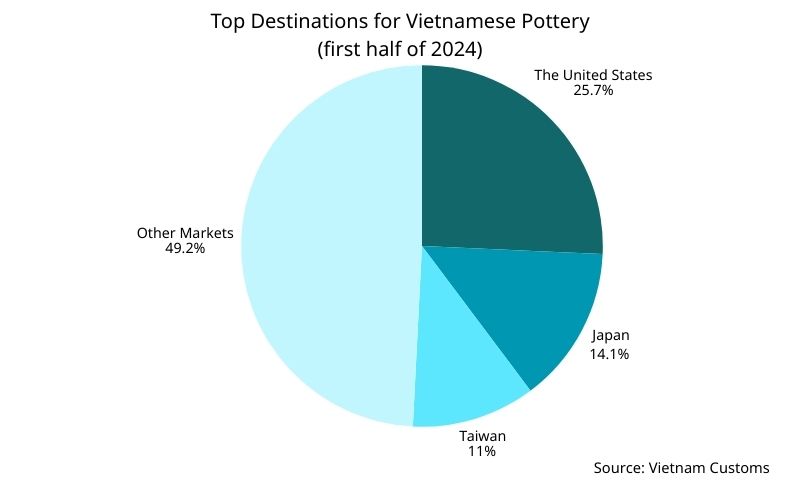
Why Are International Buyers Paying Attention To Vietnam-Made Pottery / Ceramic Products?
As you’ve just seen, Vietnam’s pottery exports have been growing steadily and are now found in many major markets. So what makes these products worth considering for your business?
- Vietnam has a long-standing tradition in pottery, with many items still handcrafted and hand-painted. Manufacturers combine artisan skill with modern standards like ISO, FDA (US), and LFGB (EU) certifications
- Labor costs in Vietnam are much lower than in China, around $3/hour versus $6.5/hour. Lower production costs mean better profit margins for importers and retailers
- Trade agreements such as EVFTA and CPTPP reduce import taxes significantly. Most ceramic products now enter the EU, Japan, and Australia with little to no tariffs
Popular Types of Vietnamese Pottery You Can Source
Vietnam offers a wide variety of pottery products. If you’re still deciding what type of items might fit best with your business, here’s a quick look that could give you some ideas:
1. Home Décor Pottery
Think of flower vases, ceramic lamps, or small figurines of people and animals. In 2023, Vietnam exported approximately USD 106 million worth of ornamental ceramics, with the U.S. alone importing over USD 58 million.
Simple, minimalist pottery products, such as matte-finished planters or unglazed vases, are consistently in demand in the U.S. and EU home décor markets. Meanwhile, sophisticated pieces with traditional Vietnamese designs like dragons, phoenixes, or lotus flowers, finished with a glossy coat, serve the premium segment.
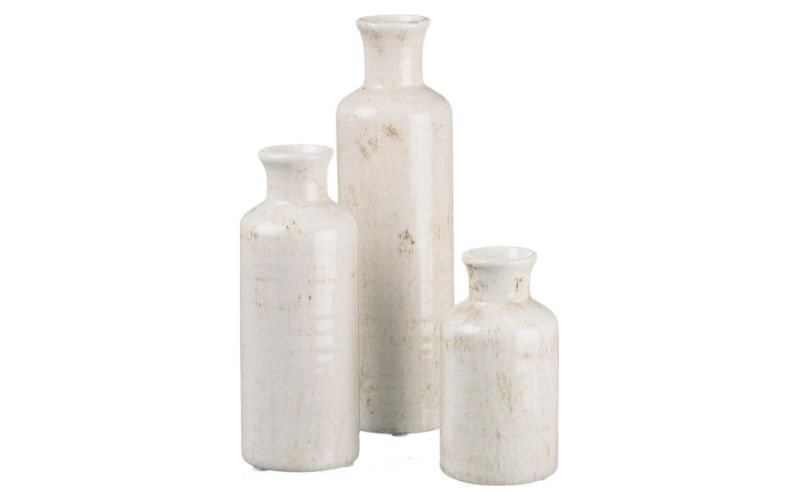
2. Tableware & Kitchenware
You’ll often see the everyday pieces we all use, like bowls, plates, cups, and tea sets, along with ceramic pots and pans. These are valued at about USD $3.31 million in 2023.
Popular export items include minimalist stoneware bowls, vintage-inspired ceramic mugs, and Vietnamese-style tea sets with bamboo handles. These items are especially well-received in the US and Europe.
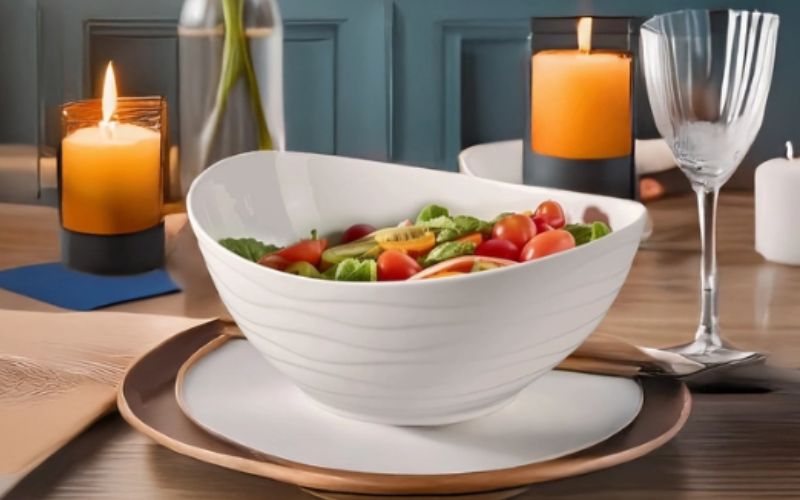
3. Garden Pots & Planters
This is a category that many buyers find exciting. It includes things like outdoor jars, fountains, and plant pots of all shapes and sizes. While there’s no direct export data for ceramic planters and pots alone, the outlook is promising as garden pottery is among the most visible product lines in catalogs of major Vietnamese suppliers.
Key importers of these items are from the United States, Australia, France, and Spain. Such markets witness rising trends in outdoor living and sustainable decor, which drives strong demand for handcrafted ceramic planters.
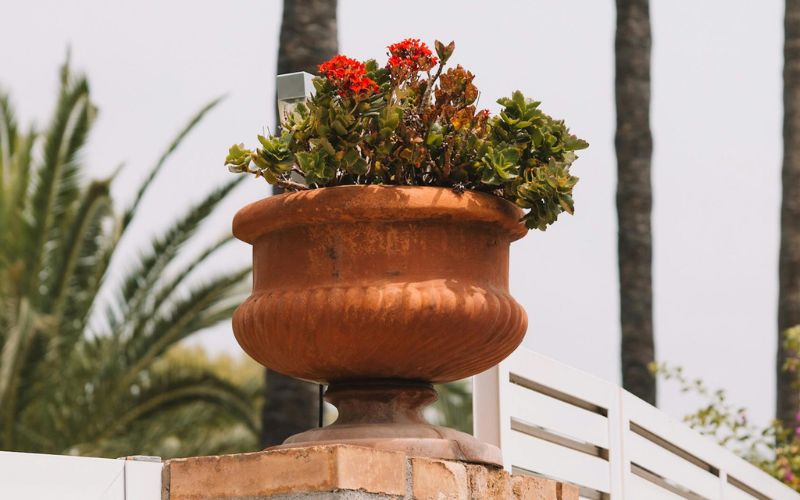
4. Construction Items
Vietnam is now one of the top ten producers of construction ceramics in the world, and it actually ranks fourth in tile production. That includes ceramic, porcelain, and cotto tiles. The sanitary ware sector has also been growing fast, with items like sinks, basins, and bathtubs. In fact, these products are already making their way to many markets around the globe, especially ASEAN countries, Northeast Asia, the United States, and Europe.
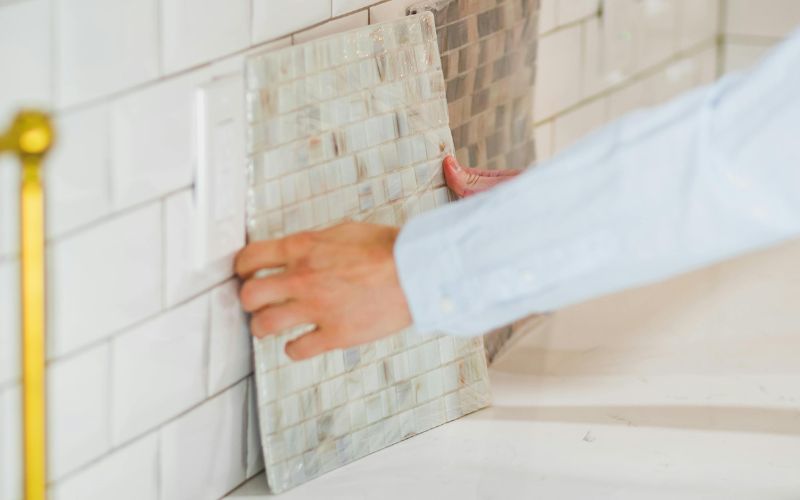
Typical MOQ and Production Lead Time for Vietnamese Pottery
When talking about minimum order quantity, most Vietnamese pottery makers may require a few thousand pieces, or sometimes a full 20-foot container. Production usually takes anywhere from one to three months, depending on how complex the designs are, how many finishing steps are required, and which season the order is placed in. If you’d like a new mold for your own design, it’s good to allow a few extra weeks.
To give you an idea, here’s a simple comparison across some of the main product types. Keep in mind that these numbers can vary depending on the supplier and the exact item you’re looking for.
| # | Main Category | Common MOQ | Typical Lead Time |
| 1 | Home décor pottery (vases, lamps, figurines) | Full 20-foot container | 30 – 60 days |
| 2 | Tableware and kitchenware (bowls, plates, cups, saucepans) | Around 500 – 1000 units | 30 – 45 days |
| 3 | Garden pots and planters (pots, jars, urns) | About 200 pieces or more per design | 60 days or longer |
| 4 | Tiles and construction ceramics | Usually 100 square meters | 30 days or longer |
Where To Find Pottery Suppliers From Vietnam
Naturally, as you look into how to import pottery from Vietnam, one big question is where to meet the real makers. Don’t worry, there are some simple ways to get started.
1. Visit Traditional Pottery Villages in Vietnam
A trip to Vietnam’s pottery villages gives you the chance to hold the pieces, watch how they’re made, and really feel the story behind them. Each village is full of family workshops that have been running for generations, often focusing on one style or product. A few villages you might want to keep on your list:
- Bat Trang, just outside Hanoi, is the most famous. For centuries, families here have made tea sets and décor in white porcelain, often finished with celadon, brown glazes, or the distinct blue-and-white Hue style.
- Phuoc Tich (Hue), located in the central region of Vietnam, is known for its unglazed pottery. The reddish-brown clay from the O Lau River gives its tea sets, vases, and planters a rustic, natural charm.
- Thanh Ha (Quang Nam) is located near Phuoc Tich and is a great place to find smaller pieces like mugs, figurines, and oil diffusers. They make for lovely décor or unique gifts.
Of course, traveling takes time and money, and you’ll need to step away from your business for a while. Not every artisan speaks English either, so having a local translator by your side can make things much easier.
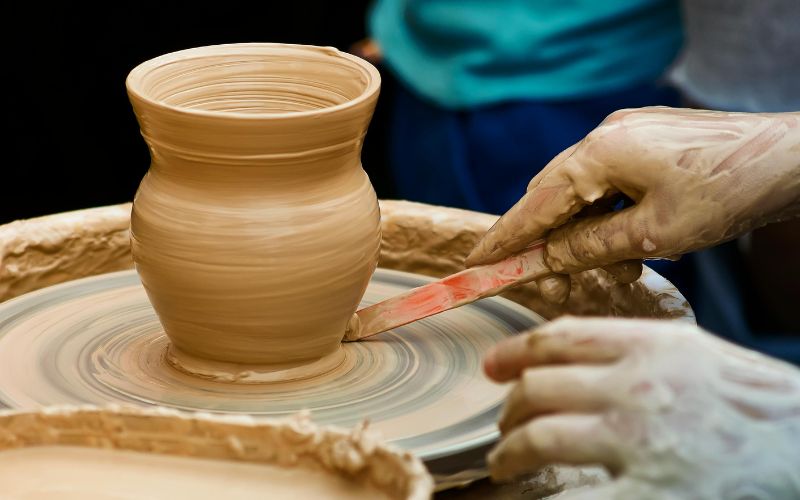
2. Join Pottery Trade Fairs in Vietnam
Visiting trade fairs is another great way to explore suppliers. You get to walk around, see the products up close, and have real conversations with manufacturers. This can help you understand who might be the right fit for your business. A couple of events you may want to keep on your calendar:
- The Vietnam Home & Garden Expo, usually in early December, brings together suppliers of home décor and garden pottery.
- VIFA Expo, often held in early March, connects international buyers with makers of ceramics as well as other handcrafted products.
Just remember, these fairs only run once a year and last a few days, so timing is important.
3. Check Out Online Pottery-Sourcing Platforms
These days, you don’t always need to jump on a plane to find suppliers. With just a few clicks, you can browse B2B platforms and see plenty of Vietnamese pottery makers and their products. It’s a quick and convenient way to get an overview of what’s out there. You can browse Alibaba and Global Sources for general B2B listings, or visit ceramic-focused platforms like VinaSources, PotteryVietnam.com and BatTrangCeramics.com.
The only catch is that not all information online is complete or verified. It’s better to stick with platforms that check their suppliers and, ideally, offer some support with the export process from Vietnam to your country.
Challenges When Working With Vietnamese Pottery Suppliers
Sourcing pottery from Vietnam can be very rewarding. The products are detailed and durable. Still, there are a few things that often come up when buyers work with local suppliers.
- Consistency. Many workshops are family-run, and while the craftsmanship is impressive, sizes and finishes don’t always come out exactly the same.
- Timing. Production often slows down around the Lunar New Year holiday in January and February, and many factories are also packed with orders from September to November as they prepare shipments for the New Year.
- Communication. The mix of language differences, time zones, and ways of working can make it harder to explain details clearly. Using simple drawings, reference photos, or working with a local sourcing partner can make conversations a lot smoother.
Other Considerations When Importing Pottery From Vietnam
In this part of the How to import pottery from Vietnam guide, let’s go over a few customs and paperwork notes you shouldn’t miss.
1. Understand Incoterms Before Signing Any Deal
Incoterms simply set out who’s responsible for what during shipping. If you’ve handled sea freight before, FOB might work well since the supplier takes care of things until the goods are loaded onto the ship in Vietnam, and then it’s your turn.
But if you’d rather keep things simple, DDP is the easiest option. Essentially, the supplier handles almost everything, including insurance, until the pottery reaches your warehouse.
2. Know the Required Documents for Pottery Imports
Like with any export, you’ll need the right set of papers to clear customs. Usually, this means:
- Commercial invoice
- Packing list
- Certificate of origin
- Bill of lading or airway bill
- Sales contract
Depending on where you’re based, there might be a few extras. For example, in the EU or UK, you’ll need an EORI number, and in the US, you’ll need to file an Importer Security Filing before the ship leaves port. You may also need EPA compliance documentation if the ceramics are glazed, and FDA prior notice if they are used for food contact.
3. Confirm the Correct HS Code and Import Tariffs for Pottery Products
If the HS code is not correct, you might end up paying the wrong taxes or VAT, and in the worst case, customs could fine you or even hold your shipment.
The good news is it’s easy to check. You can ask your supplier to confirm the HS code for your products, or you can look it up on your local customs website. Below are examples of commonly used HS Codes for Vietnamese pottery and ceramic products:
| Product Type | HS Code | Notes |
| Ceramic tableware, kitchenware, household articles | 6912.00 | Ceramic tableware, kitchenware, other household articles and toilet articles, other than of porcelain or china |
| Statuettes & other ornamental ceramic articles | 6913.90 | Other decorative/ornamental ceramic items; vases, figurines, etc. |
4. Use Protective Packaging and Get Cargo Insurance
Ceramic items are fragile, so good packaging is the key to making sure they arrive at your warehouse safe and sound. Here are a few things worth noting:
- Choose suppliers experienced in fragile goods handling
- Standard packing: double cartons, foam padding, anti-shift layers
- For large items: wooden pallets, plastic wrap, tight strapping
- Prefer CIF terms (shipping + insurance covered to destination port)
Before sealing any deal, ask for full clarity. Check if the quoted price already includes packaging and insurance, when samples and final orders will be delivered, what happens if there are delays, and how customs clearance will be handled in your market.
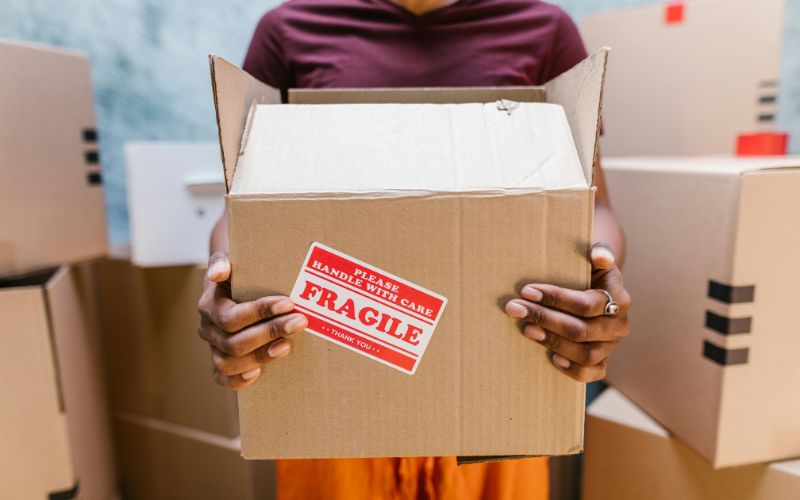
5. Check Labeling and Certification Rules in Your Market
Besides getting your export paperwork ready, you’ll also need to make sure your products meet the labeling rules in your country. Most markets usually ask for a few basics on the label:
- The exact product name
- The country of origin, which in this case should say Made in Vietnam
- The name and address of the manufacturer or importer
That’s the general part, but if you’re bringing in items like tableware or cookware that come into direct contact with food or drinks, then the bar is set higher. Most countries also require test certificates for lead and cadmium, along with food safety approvals like the FDA in the US or LFGB in the EU.
6. Work With a Customs Broker for Smooth Clearance
It’s true you’ll need to pay a fee, but in return, the customs broker takes care of the tough parts: filing paperwork, making sure duties and taxes are accurate, and keeping your shipment moving. Just make sure you pick a broker who already has experience with pottery and knows the rules in your market.
VinaSources: Your Trusted B2B Partner for Buying Pottery from Vietnam
We know that handling everything on your own can feel a bit overwhelming. On top of that, finding a reliable pottery supplier in Vietnam isn’t always simple. Many buyers still rely on word of mouth, which doesn’t always guarantee quality. And the truth is, a lot of the best workshops don’t even have a website, and only a few big B2B platforms, like Alibaba, actually let you review a seller’s profile in detail.
That’s where VinaSources can really make things easier. We connect you directly with trusted pottery workshops in Vietnam and stay by your side throughout the process, from sourcing and quality checks to logistics and compliance. Whether you’re after decorative vases, everyday tableware, or durable cookware, chances are our ceramic catalogue already has the right supplier for you.
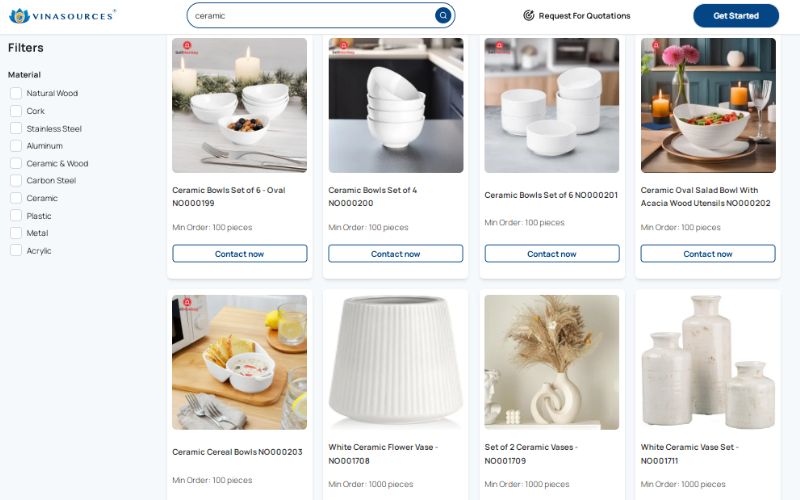
Here’s how to source pottery products from VinaSources:
- You can either browse our products or just tell us what you’re looking for, like ceramic type, quantity, target price, and any other details.
- We gather quotes from many reliable suppliers and share the best matches with you.
- We take care of the export side, including inspections, shipping, paperwork, tracking, and even warehousing if you need it.
Submit your RFQ and receive multiple verified quotes today!
